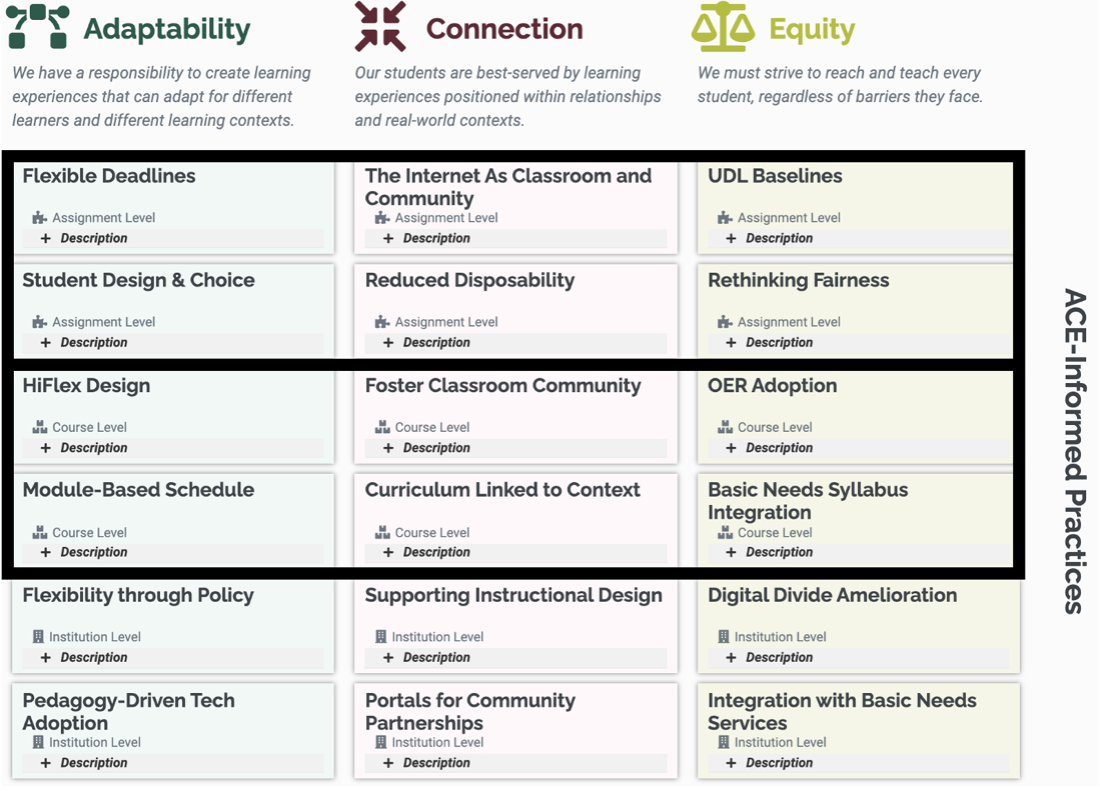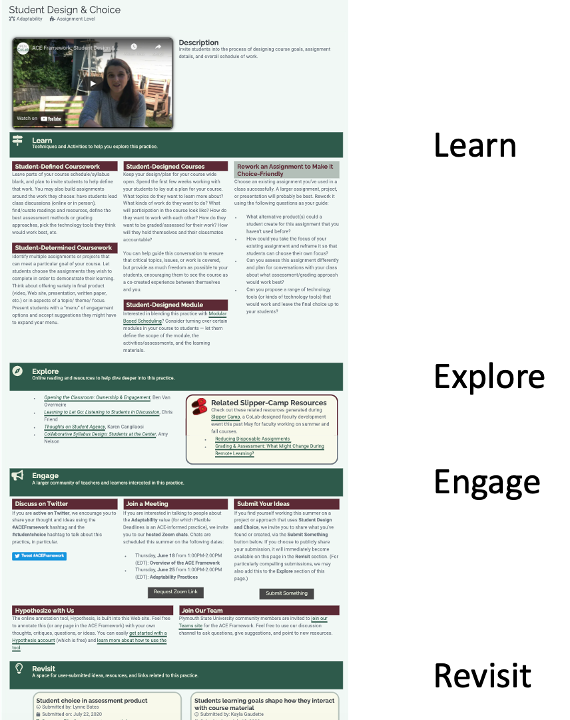Adaptability, Connection & Equity: Using the ACE Framework as a guide

About the ACE Framework
The COVID-19 pandemic has highlighted and exacerbated inequities that have always hindered learning for vulnerable populations. Increased pressures, financial obstacles, and limited resources, and increased isolation are just some of the conditions that are making it more difficult for students to perform well. The ACE Framework was developed in an effort to support students in completing their studies. The framework is based on the following values:
Adaptability: We have a responsibility to create learning experiences that can adapt for different learners and different learning contexts.
Connection: Our students are best-served by learning experiences positioned within relationships and real-world contexts.
Equity: We must strive to reach and teach every student, regardless of barriers they face.
The ACE Framework does not provide guidance about pedagogy or about how to use educational technology. Rather, it suggests approaches for modifying the course structure to make it more COVID-ready. In exploring the framework, you might discover that there are techniques that you’ll want to adapt permanently; some inequities will always exist, with or without a pandemic.
The ACE Framework was developed and openly licensed by the Open Learning & Teaching Collaborative (CoLAB) at Plymouth State University. The framework is licensed under a Creative Commons Attribution-ShareAlike 4.0 International License. The content if this entire section carries the same license.
Navigating the ACE Framework
The ACE Framework is shown in Figure 3.1. The framework is organized into three columns – one for each of the framework’s values: Adaptability, Connection, and Equity. The top two rows pertain to the assignment level and are identified with a black outline of a rectangle. The middle two rows pertain to the course level . They are also identified with the black outline of a rectangle. These four rows are most relevant to instructors. The bottom two rows pertain to the institution level. The actions described at the institution level are most relevant to administrators; they support actions at the course and assignment levels.

You can navigate the framework if you head to the ACE Framework website. This resource was first created in early 2020, as North America first went into lockdown after it was announced that there was a COVID-19 pandemic. The site is regularly updated, so you may notice changes if you visit it often. When you click on the title in bold in any cell, a page will open like that in Figure 3.2. Each page has the title of the section at the top left. Just below the title is an introductory video where a member of the CoLAB explains the topic of the page. There are four sections on the page, as shown in Figure 3.2: Learn, Explore, Engage, Revisit.

In the Learn section, you will find several suggestions for adapting your assignments or courses according to the topic of the page. You can choose to adopt or adapt any of these ideas. Alternatively, you might be inspired to come up with your own ideas that may be better suited to your subject or context. In the Explore section, there are links to resources that provide information about the topic at hand. These sources are not exhaustive; they provide a few perspectives on the topic and can lead you to further resources. The Engage section presents options for engaging with other instructors who are applying the ACE Framework. You can discuss ideas on Twitter using the #ACEFramework hashtag or you can submit ideas that you’ve thought of or applied in your courses. You can also open a free account with the open source tool called Hypothes.is. This tool allows users to annotate web pages and PDFs and to hold discussions in the right margin of the page.
At the bottom of each topic page is the Revisit section which contains ideas and thoughts submitted by users like you. They tend to offer brief descriptions of specific instances of applying the ACE Framework. They may also contain linked documents for further guidance on how to implement the ideas.
While the ACE Framework applies to most courses, it may be more difficult to apply in some circumstances. For this reason, there is a link called “Complicating the Conversation” at the bottom left of the main page of the ACE Framework. On this page are extra resources provided for increasing Adaptability, Connection, and Equity as is relevant for the following topics: Experiential Learning, Project-Based Learning, Large Lecture Learning, Exam-Intense Learning & Proctoring, and Supporting First-Year Students Online. Additionally, there is an ACE Student Guide at the bottom right of the ACE Framework main page which acknowledges the struggles students may be experiencing as they try to pursue their studies in difficult times and provides suggestions, information resources, and tools to support learning.
Suggested approach for using the ACE Framework
Within each of the Adaptability, Connection, and Equity columns, select two topics. They could both be from the Assignment Level or from the Course Level. Or you might want to choose one topic from each of these levels. Download the Worksheet linked below. Copy the topic names into the respective spaces in Table 1 in the Worksheet. For each topic, explore the page sections. Select two ideas from the Learn (or Revisit) section that you think could be useful for your students. Place them in the table so that each idea occupies one cell. Do the same for the Explore and Engage sections, if you think you have the time and energy to explore additional resources or engage with other instructors. The important thing is not to fill the table, but rather to select ideas and resources from the ACE Framework that you think would be beneficial for your students and realistic for you to implement. Once you have completed Table 1, use a similar approach to complete Tables 2 and 3. Implement your changes, and pay attention to how your students respond. Make adjustments as you see fit. If you want further support in increasing the Adaptability, Connection, and Equity of your courses, be sure to contact the MacPherson Institute and chat with an Educational Developer.
Worksheet for Applying the ACE Framework
Attribution for first image:
Untitled photo by Scott Lewis is licensed under a Creative Commons Attribution 2.0 International License.This image was adapted from the original.

